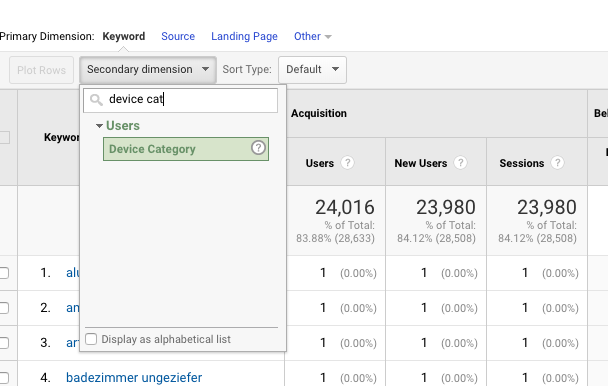Maximizing Search Engine Optimization with Secondary Dimension in Google Analytics
Maximize Reporting Precision With Additional Dimension in Google Analytics
Recognizing how to make the most of reporting precision with secondary dimensions in Google Analytics can substantially boost the depth of insights acquired from data analysis. By including secondary measurements strategically, online marketers can uncover concealed patterns and relationships that might not be promptly obvious when evaluating primary metrics alone.
Recognizing Second Dimensions in Google Analytics
To boost information analysis and gain deeper insights right into customer actions, recognizing additional dimensions in Google Analytics is imperative. Additional measurements enable users to segment and further explore data past the key measurement picked. By integrating secondary measurements, analysts can refine their reports to reveal more detailed information concerning user communications on a web site. For instance, while the primary dimension might display the total number of page sights, adding a second dimension such as 'source/medium' can provide understandings into where the website traffic originated from. This additional layer of info allows marketing experts to examine the efficiency of different advertising and marketing campaigns or channels in driving web traffic to the web site.
In addition, recognizing secondary dimensions is important for creating much more personalized records tailored to specific organization goals. By picking the appropriate mix of main and secondary dimensions, experts can discover patterns, fads, and relationships that may otherwise remain surprise. This nuanced method to data analysis empowers services to make educated decisions based on a thorough understanding of user habits across various dimensions.

Exactly How to Apply Additional Measurements
When leveraging additional measurements in Google Analytics, the functional application involves choosing details data criteria to further improve insights beyond the main dimension's scope. To apply secondary measurements effectively, begin by accessing the record or dataset where you want to dive deeper into the information. Bear in mind that second measurements assist give context and granularity to your key measurement information, enabling you to draw out even more meaningful and actionable insights from your Google Analytics records.
Leveraging Additional Dimensions for Insights
Using secondary dimensions in Google Analytics enables a much more comprehensive evaluation of data, using valuable insights past the primary measurement's range. By leveraging secondary measurements, customers can dig much deeper into the efficiency metrics of their site or application, discovering hidden patterns and patterns that may not be instantly evident when only checking out primary measurements.
One key advantage of making use of secondary measurements is the ability to sector and filter information much more precisely. This can assist marketing experts and experts better understand the actions of particular customer sectors, such as new site visitors versus returning site visitors, or traffic coming from various geographic areas.
Furthermore, second dimensions make it possible for individuals to compare and comparison numerous information factors within the exact same record, offering an extra alternative sight of performance (Secondary Dimension in Google Analytics). Combining the primary dimension of landing pages with second dimensions like tools or demographics can expose which pages are most reliable in involving individuals on various devices or from different market groups.
Essentially, leveraging secondary dimensions in Google Analytics equips users to extract richer insights from their data, leading to more educated decision-making and ultimately, boosted performance.
Ideal Practices for Additional Measurements
When assessing information in Google Analytics, incorporating second measurements effectively boosts the depth of understandings acquired from the key metrics. To make the most out of second dimensions, it is important to follow finest practices that make certain precise and purposeful reporting. To start with, it is essential to pick site link additional measurements that align with the main statistics you are examining. Picking appropriate additional dimensions aids in supplying context and a more clear understanding of the data being taken a look at.
Furthermore, it is suggested to limit the variety of additional dimensions used in a single record to prevent frustrating the evaluation with excessive information. Focusing on a few crucial second dimensions at once can lead to even more focused and actionable understandings. In addition, think about trying out with different combinations of key and second measurements to reveal unique fads and patterns that may not appear when checking out the information alone.
Advanced Evaluation Strategies With Second Dimensions
Exploring intricate data partnerships with the calculated application of additional dimensions can unveil nuanced understandings that boost the depth of analysis in Google Analytics. By combining secondary measurements with primary data sets, advanced analysis methods can be utilized to draw out useful info.
Additionally, second dimensions can enhance the evaluation of conversion paths by offering additional context. Understanding the numerous touchpoints an individual interacts with prior to transforming can be essential in maximizing the client journey - Secondary Dimension in Google Analytics. By making use of additional dimensions to explore specifics such as web traffic sources or devices made use of, marketing experts can customize methods Get More Info to target high-converting channels efficiently
Final Thought

To boost information evaluation and gain much deeper understandings right into individual habits, recognizing secondary measurements in Google Analytics is imperative - Secondary Dimension pop over here in Google Analytics. Secondary dimensions enable customers to sector and further dissect data beyond the main dimension picked. While the primary dimension may display the total number of page sights, adding an additional dimension such as 'source/medium' can supply understandings right into where the web traffic stemmed from.When leveraging second measurements in Google Analytics, the functional application entails picking specific information parameters to further refine insights beyond the main dimension's range. Keep in mind that additional measurements aid give context and granularity to your key measurement data, allowing you to extract more purposeful and workable understandings from your Google Analytics reports